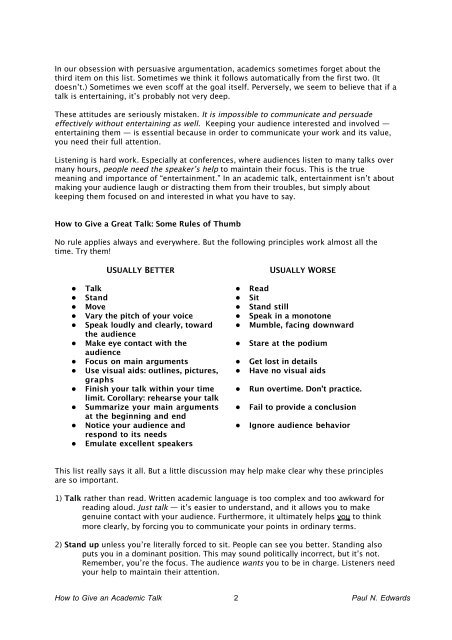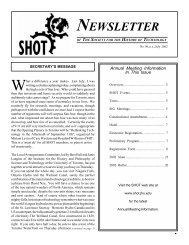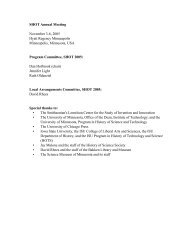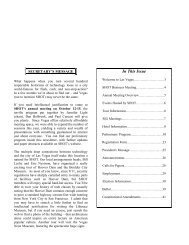How to Give an Academic Talk - Society for the History of Technology
How to Give an Academic Talk - Society for the History of Technology
How to Give an Academic Talk - Society for the History of Technology
You also want an ePaper? Increase the reach of your titles
YUMPU automatically turns print PDFs into web optimized ePapers that Google loves.
In our obsession with persuasive argumentation, academics sometimes <strong>for</strong>get about <strong>the</strong><br />
third item on this list. Sometimes we think it follows au<strong>to</strong>matically from <strong>the</strong> first two. (It<br />
doesn’t.) Sometimes we even sc<strong>of</strong>f at <strong>the</strong> goal itself. Perversely, we seem <strong>to</strong> believe that if a<br />
talk is entertaining, it’s probably not very deep.<br />
These attitudes are seriously mistaken. It is impossible <strong>to</strong> communicate <strong>an</strong>d persuade<br />
effectively without entertaining as well. Keeping your audience interested <strong>an</strong>d involved —<br />
entertaining <strong>the</strong>m — is essential because in order <strong>to</strong> communicate your work <strong>an</strong>d its value,<br />
you need <strong>the</strong>ir full attention.<br />
Listening is hard work. Especially at conferences, where audiences listen <strong>to</strong> m<strong>an</strong>y talks over<br />
m<strong>an</strong>y hours, people need <strong>the</strong> speaker’s help <strong>to</strong> maintain <strong>the</strong>ir focus. This is <strong>the</strong> true<br />
me<strong>an</strong>ing <strong>an</strong>d import<strong>an</strong>ce <strong>of</strong> “entertainment.” In <strong>an</strong> academic talk, entertainment isn’t about<br />
making your audience laugh or distracting <strong>the</strong>m from <strong>the</strong>ir troubles, but simply about<br />
keeping <strong>the</strong>m focused on <strong>an</strong>d interested in what you have <strong>to</strong> say.<br />
<strong>How</strong> <strong>to</strong> <strong>Give</strong> a Great <strong>Talk</strong>: Some Rules <strong>of</strong> Thumb<br />
No rule applies always <strong>an</strong>d everywhere. But <strong>the</strong> following principles work almost all <strong>the</strong><br />
time. Try <strong>the</strong>m!<br />
USUALLY BETTER USUALLY WORSE<br />
• <strong>Talk</strong> • Read<br />
• St<strong>an</strong>d • Sit<br />
• Move • St<strong>an</strong>d still<br />
• Vary <strong>the</strong> pitch <strong>of</strong> your voice • Speak in a mono<strong>to</strong>ne<br />
• Speak loudly <strong>an</strong>d clearly, <strong>to</strong>ward<br />
<strong>the</strong> audience<br />
• Mumble, facing downward<br />
• Make eye contact with <strong>the</strong><br />
audience<br />
• Stare at <strong>the</strong> podium<br />
• Focus on main arguments • Get lost in details<br />
• Use visual aids: outlines, pictures,<br />
graphs<br />
• Have no visual aids<br />
• Finish your talk within your time<br />
limit. Corollary: rehearse your talk<br />
• Run overtime. Don’t practice.<br />
• Summarize your main arguments<br />
at <strong>the</strong> beginning <strong>an</strong>d end<br />
• Fail <strong>to</strong> provide a conclusion<br />
• Notice your audience <strong>an</strong>d<br />
respond <strong>to</strong> its needs<br />
• Ignore audience behavior<br />
• Emulate excellent speakers<br />
This list really says it all. But a little discussion may help make clear why <strong>the</strong>se principles<br />
are so import<strong>an</strong>t.<br />
1) <strong>Talk</strong> ra<strong>the</strong>r th<strong>an</strong> read. Written academic l<strong>an</strong>guage is <strong>to</strong>o complex <strong>an</strong>d <strong>to</strong>o awkward <strong>for</strong><br />
reading aloud. Just talk — it’s easier <strong>to</strong> underst<strong>an</strong>d, <strong>an</strong>d it allows you <strong>to</strong> make<br />
genuine contact with your audience. Fur<strong>the</strong>rmore, it ultimately helps you <strong>to</strong> think<br />
more clearly, by <strong>for</strong>cing you <strong>to</strong> communicate your points in ordinary terms.<br />
2) St<strong>an</strong>d up unless you’re literally <strong>for</strong>ced <strong>to</strong> sit. People c<strong>an</strong> see you better. St<strong>an</strong>ding also<br />
puts you in a domin<strong>an</strong>t position. This may sound politically incorrect, but it’s not.<br />
Remember, you’re <strong>the</strong> focus. The audience w<strong>an</strong>ts you <strong>to</strong> be in charge. Listeners need<br />
your help <strong>to</strong> maintain <strong>the</strong>ir attention.<br />
<strong>How</strong> <strong>to</strong> <strong>Give</strong> <strong>an</strong> <strong>Academic</strong> <strong>Talk</strong> 2<br />
Paul N. Edwards





